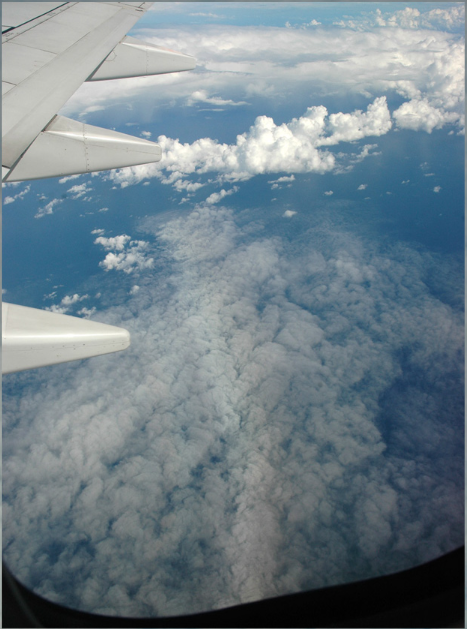Cloud Contrast Bows
Cloud Contrast Bows: Enhancing the Beauty of the Sky
Clouds have always captivated our imagination with their ever-changing shapes and colors. But have you ever noticed a white arc drifting across the clouds, seemingly enhancing the contrast between the cloud tops and hollows? This mesmerizing phenomenon is known as a "cloud contrast bow." In this article, we will delve into the intricacies of cloud contrast bows and explore the science behind their formation.
A cloud contrast bow is a type of cloudbow or fogbow, which are the cloud and mist droplet counterparts of the more familiar rainbow formed by raindrops. However, there are some key differences. Cloud droplets are significantly smaller, ranging from 1/1000 to 1/10 mm in size. Due to their small size, these droplets diffract light waves differently, resulting in a broad and diffuse cloudbow rather than a sharply defined rainbow.
The enhanced contrast seen in cloud contrast bows can be attributed to the scattering of light within an uneven cloud deck. Light from the upper parts of the cloud deck has a higher probability of undergoing single scattering, which produces a bright cloudbow. On the other hand, sunlight from the cloud hollows scatters multiple times, leading to a lack of cloudbow formation in those areas. As a result, the hollows appear darker when viewed at the cloudbow angles, thus enhancing the contrast between them and the cloud tops.
When observing a cloud contrast bow, keen observers may notice traces of a red outer edge. This phenomenon indicates that the cloud droplets responsible for the bow are larger in size compared to those creating a typical cloudbow. The presence of larger droplets affects the diffraction of light waves, causing a slight shift towards longer wavelengths such as red. This subtle touch adds an extra layer of beauty to an already enchanting spectacle.
Cloud contrast bows can be observed in various locations around the world. Fabiano Diniz, an avid photographer and sky enthusiast, captured stunning images of these bows during his flights over Argentina and Brazil. These photographs serve as a testament to the allure and widespread occurrence of this atmospheric phenomenon.
In conclusion, cloud contrast bows are a captivating display of nature's artistic prowess. The interplay between light and cloud droplets creates a visual spectacle that enchants observers worldwide. By understanding the science behind their formation, we can appreciate the intricate mechanisms at play and gain a deeper appreciation for the beauty that surrounds us in the sky.
So, the next time you find yourself gazing up at the clouds, keep an eye out for the elusive cloud contrast bow. It may just be waiting to grace your view with its ethereal presence, reminding us of the wonders that can be found in even the simplest of natural phenomena.

Cloud Contrast Bow pictured by Fabiano Diniz on a flight in Argentina from Buenos Aires to Ushuaia. ©Fabiano Diniz, shown with permission.
A white arc drifts with the aircraft across the clouds. It is rendered more visible by the enhanced contrast between the cloud tops and hollows.

The arc, a �cloud contrast bow�, is a form of cloudbow or fogbow. They are the cloud and mist droplet counterparts of the raindrop generated rainbow. Cloud droplets are far smaller, 1/1000 � 1/10 mm across. They appreciably diffract light waves to form a broad and diffuse cloudbow rather than a sharply defined rainbow.
The contrast enhancement arises because light from upper parts of an uneven cloud deck has a greater probability of being scattered once only. Single scattering produces a bright cloudbow. Sunlight from cloud hollows is scattered several times and those rays do not make a cloudbow. The hollows therefore appear darker at the cloudbow angles. Contrast between hollows and cloud tops is apparently enhanced.

A second cloudbow by Fabiano Diniz seen this time on a journey over Brazil from Curitiba to Rio de Janeiro.
Here we know that the cloud droplets are larger because the bow has traces of a red outer edge.
The clouds again show enhanced contrast in the region of the bow.
Note: this article has been automatically converted from the old site and may not appear as intended. You can find the original article here.
Reference Atmospheric Optics
If you use any of the definitions, information, or data presented on Atmospheric Optics, please copy the link or reference below to properly credit us as the reference source. Thank you!
-
<a href="https://atoptics.co.uk/blog/cloud-contrast-bows/">Cloud Contrast Bows</a>
-
"Cloud Contrast Bows". Atmospheric Optics. Accessed on November 26, 2024. https://atoptics.co.uk/blog/cloud-contrast-bows/.
-
"Cloud Contrast Bows". Atmospheric Optics, https://atoptics.co.uk/blog/cloud-contrast-bows/. Accessed 26 November, 2024
-
Cloud Contrast Bows. Atmospheric Optics. Retrieved from https://atoptics.co.uk/blog/cloud-contrast-bows/.